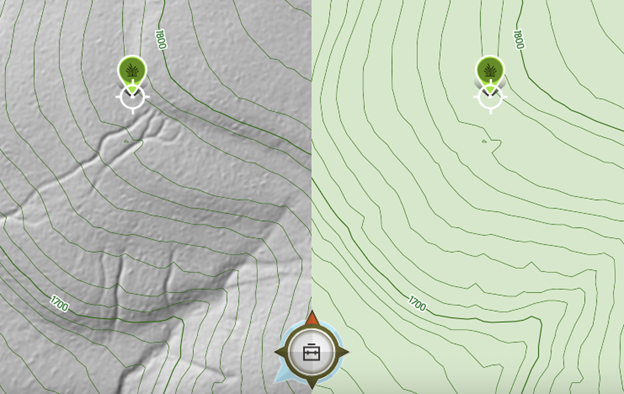E-Scouting for Wild Onions: Finding Leeks & Ramps

Using Modern Mapping Technology to Find Wild Onions
As many of you know, there is really no offseason when it comes to hunting, fishing, and the great outdoors. However, late winter and early spring can have you looking for excuses to get outside. Foraging for tasty wild onions, also known as leeks or ramps, is a great way to spend that time.
For those of us that have our coveted leek spots, foraging for these leeks can be as simple as going to the same spot year after year and being careful not to over harvest them. If you have never found them before, they can be challenging to locate if you don’t know where to look.
LIDAR is your friend here and can help you narrow down an area and find leeks easier!
What are Leeks and Ramps?
Allium tricoccum, more commonly known as a ramp or wild leek, are a wild onion that is mostly found in the eastern United States. They grow in the deciduous forests and are highly regarded table fare in the Appalachian regions.
They mostly grow in small patches but I have found areas where leeks are abundant enough to cover an entire football field. Unlike most onion varieties, wild leeks grow very distinct leaves that are easily identified when out in the woods. These onion bulbs grow one to three leaves that are wide and smooth. Their thin stalks look similar to the green onions that you find in the store and have a very strong flavor.
Both the bulb and the leaves are edible and provide a very unique spring taste to any dish. The bulb flavor is a mixture of both onion and garlic and sometimes takes a little getting used to. While the big leaves have an earthy taste and compliment the taste of the bulb itself!
As mentioned before, these are primarily found in the eastern United States. Their range goes as far south as Alabama and as far north as Maine. They are also found as far west as North Dakota!
The best time to harvest leeks is January to April each year. The earlier you pick them the stronger they taste. Those small early bulbs work great in dips, while the later large bulbs are better for soups and pickling.

Using LIDAR to Find Wild Onions
E-Scouting for foraging may seem like a wild idea, but it actually isn’t. With the technology found in your pocket you can reduce the amount of time it takes for you to find things like leeks. You still need to have the knowledge of where they grow, but once you figure that part out, the sky is your limit!
Leeks like spring seeps. Plain and simple. While that doesn’t mean that that is the only place that they will grow, it is a great starting point. The LIDAR layer on Spartan Forge is invaluable when finding these seeps. LIDAR essentially removes the foliage from the landscape and allows you to see what the ground is doing underneath the canopy of trees. In most of the United States, Spartan Forge has 1-meter accuracy which makes spring seeps really stand out!
Compared to a standard topo map, the detail of LIDAR is unmatched. Logging roads, trails, and of course spring seeps are easily recognizable. Leeks also tend to like north-facing slopes in hardwood forests. This isn’t a rule however, but can help you narrow down an area to find them.
Picking Leeks
Leeks are relatively easy to harvest but do require you to be mindful of the amount you harvest due to their long growth cycles. While they are a perennial, it can take 5 or more years to get them back to the sizes most commonly harvested. Most recommend harvest around ten percent of the selected patch. This will ensure that the patch will be healthy year after year.
To pick leeks, simply use a small garden trowel to lift the bulb out of the ground. Clean them by running fresh water over them to remove the dirt and debris found on them. I typically will rinse them off in a spring seep near where I picked them. This keeps me from getting my kitchen too dirty when I get home.

Eating Leeks
Once you get the leeks back to your house, give them another rinse in the sink and they are ready for consumption as is! Later, I will go into a couple of my favorite leek recipes.
As mentioned before, wild leeks have a very strong flavor. They taste nothing like the leeks that you see on the shelves of your local grocery store. Wild leeks can be substituted for green onions in just about any recipe for a unique twist. A little goes a long way here.
Aside from leek specific recipes, I really enjoy chopping one up and throwing it in my eggs in the morning, or garnishing a steak with the big green leaves.
Simple Leek Recipes
You can eat leeks in so many different ways, but here are a couple simple recipes that I really enjoy.
Leek Dip
Ingredients:
- 1 jar of Cheez Whiz
- 1 block of cream cheese
- 1 cap of apple cider vinegar
- 24 leeks
- 2 gloves of garlic
Beat ingredients together and store in the refrigerator
Grilled Leeks
Ingredients:
- Leeks with large leaves
- Olive oil
- Salt
- Pepper
Fold leaves over bulb, brush with olive oil, add salt and pepper, grill
Another great way to enjoy leeks is to add a full stalk and bulb into a Moscow Mule. It adds a very unique taste that is a great early spring drink.
Written by Kurtis Martonik, Spartan Forge Researcher and owner of The Gunsmithing Journal








